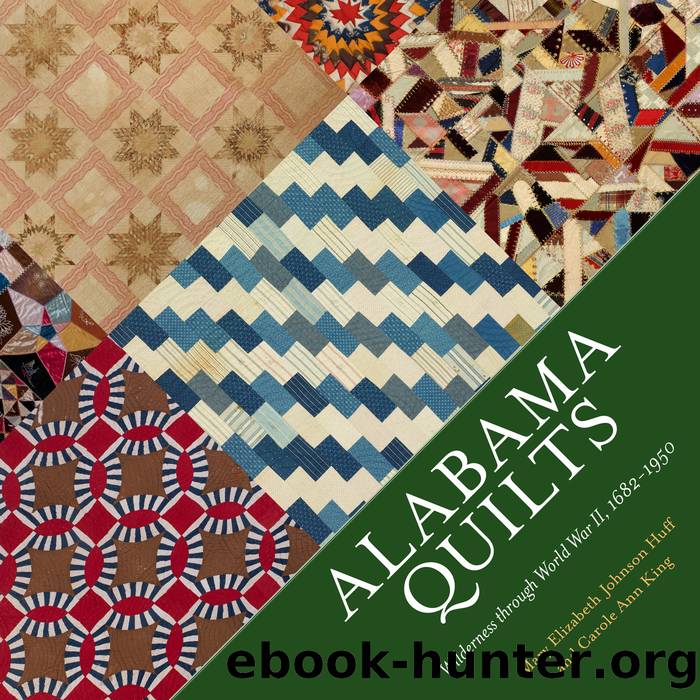Alabama Quilts: Wilderness through World War II, 1682â1950 by Mary Elizabeth Johnson Huff and Carole Ann King

Author:Mary Elizabeth Johnson Huff and Carole Ann King
Language: eng
Format: epub
Publisher: University Press of Mississippi
Published: 2020-11-15T00:00:00+00:00
The quilt was discovered in the Rose-Morris House as it was being readied for its move from near Wetumpka to Old Alabama Town in Montgomery. It is puzzling that the family should have left behind a quilt of such fine quality, but it is always a boon to scholars to find a quilt in its original location. It is intriguing to imagine a quilt of this sophistication being contained in this house, which looks rather unassuming to our eyes, but the house was quite an architectural statement for its time in early Alabama.
We saw evidence of the early existence of fraternal organizations in figure 5.12, with its representation of the Eastern Star logo. The Masons, to which one must have an affiliation in order to be a member of the Eastern Star, is a much, much older organization. The origins of âfreemasonryâ go back to as early as late fourteenth-century England, when a group of stonemasons came together to establish a standard of ethics for their workmanship and for the conditions under which they labored. At some point in its history, freemasonry became a fraternal organization with a hierarchy, rites, and rules for membership. It was in America by the 1730s, with George Washington as a member.41 There is no doubt that quite a number of the quilts documented in the AQBP come from families that proudly claim a Mason as a current member or ancestor.
The Masonic symbol consists of a T-square and compass, an acknowledgment of Euclid as the father of geometry. The quilt in figure 5.28 incorporates four of these symbols arranged around a center square, surely an original design. Mrs. Lamon made the quilt for the lodge to which her husband, Mikeuel A. Lamon, belonged. Other quilters have incorporated the Masonic emblem in their quilts. Notable is a Honeycomb quilt (not shown) of different-colored hexagons, centered by a bright yellow background square onto which a large navy T-square and compass have been appliquéd. It was made by Lelia McGlaughn in Walnut Grove (Etowah County) around 1900.42
Download
This site does not store any files on its server. We only index and link to content provided by other sites. Please contact the content providers to delete copyright contents if any and email us, we'll remove relevant links or contents immediately.
On Writing A Memoir of the Craft by Stephen King(4848)
The Doodle Revolution by Sunni Brown(4668)
A Simplified Life by Emily Ley(4081)
Mummy Knew by Lisa James(3621)
Marijuana Grower's Handbook by Ed Rosenthal(3606)
Better Homes and Gardens New Cookbook by Better Homes & Gardens(3509)
Figure Drawing for Artists by Steve Huston(3363)
Paper Parties by Erin Hung(3354)
Draw Your Day by Samantha Dion Baker(3258)
The Genius of Japanese Carpentry by Azby Brown(3209)
Japanese Design by Patricia J. Graham(3098)
The Code Book by Simon Singh(3057)
Dangerous Girls by Haas Abigail(2958)
Lions and Lace by Meagan Mckinney(2911)
The Curated Closet by Anuschka Rees(2897)
How to Make Your Own Soap by Sally Hornsey(2812)
The Checklist Manifesto by Atul Gawande(2763)
The Wardrobe Wakeup by Lois Joy Johnson(2717)
Zero to Make by David Lang(2716)
